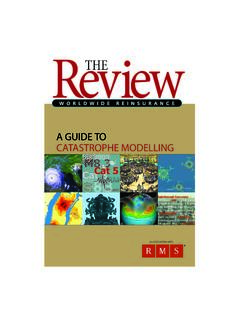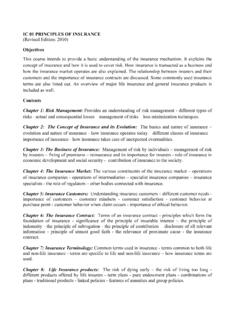Transcription of 2.1 Qualitative and quantitative approaches to risk …
1 And quantitative approaches to risk assessmentDavid C. Simmons, Rudi Dauwe, Richard Gowland, Zsuzsanna Gyenes, Alan G. King, Durk Riedstra, Stefan The importance of risk assessmentRisk assessment is a means not only to understand the risks that society (or a family or business) faces, with their potential probabilities and impacts, but also to provide a framework to determine the effectiveness of disas-ter risk management, risk prevention and/or risk would be spurious to pretend that we fully understand all the hazards that society faces and their poten-tial consequences. The process of risk assessment requires a structured approach. Without such a process, risks may be overlooked or implic-it assumptions may be made.
2 A risk assessment process requires transpar-ency, opening up assumptions and options to challenge, discussion and structured approach is required to understand all the hazards that society faces and their potential consequences. This requires transparency, opening up assumptions to challenge, discussion and assessment and mapping guide-lines for disaster management (Euro-pean Commission, 2010) and Over-view of natural and man-made disaster risks in the EU (European Commis-sion, 2014), provide a solid outline of the issues in a European context. The first outlines the processes and meth-ods of national risk assessments and mapping in the prevention, prepared-ness and planning stages, as carried out within the broader framework of disaster risk management , whereas the second paper analyses 18 national contributions, identifying 25 hazards, both natural and man-made (mali-cious and non-malicious).
3 However, as an example of the im-portance of risk assessment, the ex-perience of the insurance industry is presented, an industry that has been transformed by the adoption of an increasingly rigorous risk assessment and modelling process over the last 30 years. The lessons learnt are relevant to policymakers and practitioners in Example: catastrophe risk and the insurance industryAs recently as the 1980s, the insurance industry s catastrophe risk assessment was almost entirely based on histori-cal experience or rule of thumb as-sumptions. Catastrophes are, by defi-nition, rare events. It is very unlikely that a mega event will have occurred in recent years and, even if that were CHAPTER 2 UNDERSTANDING DISASTER RISK: RISK ASSESSMENT METHODOLOGIES AND EXAMPLES45the case, it may have had unique fea-tures that may not reoccur.
4 If we had a historical event, would it cause simi-lar damage if it reoccurred? The glob-al population is growing and getting wealthier, with the majority now con-centrated in cities. Pressure of popu-lation growth has created the need to build on land that was wisely avoided by our forefathers. Growth may be unplanned with infrastructure, such as drainage not keeping up with the rate of development. People like liv-ing close to water, potential loss may be more than just scaling the historical loss by population change and need for a better approach was clear. In 1984 Don Friedman pub-lished a paper that would form the template for modelling insurance catastrophe risk over the following 30 years, breaking the process into hazard, exposure, vulnerability and financial loss.
5 The first United States hurricane model to this template was produced by the reinsurance bro-ker Blanch in 1987 (White and Budde, 2001), followed by the United States earthquake in 1988. Reinsur-ance brokers and reinsurers also lead the field in Europe; however, the early 1990s saw the rise of three major ca-tastrophe modelling firms, which still dominated the industry in models were stochastic models based not on a few historic haz-ard events but rather on a synthetic event made of many thousands of events that attempt to represent the range of possible events with their associated probabilities. The mod-els required knowledge not only of what properties were insured and their value but also of their location, construction type and occupation.
6 Engineering principles augmented by historical loss analysis attempted to understand the relationship between the event s manifestation at a particu-lar location ( , peak ground acceler-ation, peak gust speed and maximum flood depth) and its likely damage. From this an overall damage estimate for any given property portfolio for each of the synthetic events could be calculated. If the probability of each synthetic event is then applied, we could understand the distribution off loss to the overall portfolio, for example what the annual average loss is and how big a loss from that hazard type can be expected every 5, 10, 20, 50 and 100 process of modelling catastrophe risk has transformed the reinsurance industry by increasing knowledge, scientific engagement, technical competence and, most importantly, the resilience of the industry its ability to pay could be made based on objective fact , not subjective opin-ion.
7 Underwriters now had much more information to appropriately rate individual policies and to decide how much total risk they could accept across their portfolio and how much to off lay. The concept of risk/re-turn entered the market. Firms began to clearly define their risk appetite to ensure appropriate levels of financial security and then seek to maximise re-turn within that has not been a painless process. In-itially, many saw the models as a pan-acea to the market s problems. There was a tendency by those unaware of the complexity of the models to be-lieve the results. Arguably, the mod-els were oversold and overbought: the vendors sold the models on their technical capabilities and the buyers bought them seeking certainty, but neither publically faced up to the in-herent uncertainty within the models, despite growing pains in the process.
8 However, this information has trans-formed the industry. Twenty years ago the most technical reinsurance broker had perhaps 3 % of staff engaged in risk analytics, whereas now this has become 25 % to 30 %. Chief risk of-ficers were virtually unknown in the insurance industry 20 years ago; now they are models became a mechanism to raise debate above vague opinion to a discussion of the veracity of assump-tions within the model. The models data requirements led to a massive increase in the quality and quantity of data captured, leading in turn to improved models. Knowledge of ca-tastrophe risk has grown immeasura-bly; firms have become smarter, more financially robust and therefore more likely to meet their claim such modelling originally ap-plied to catastrophe risk only, it has been extended to cover man-made hazards such as terrorism and more esoteric risk such as pandemic.
9 In-deed, the EU s solvency II (Directive 462009/138/EC) an insurance regula-tory regime, requires firms to under-stand all the risk they face, insurance and non-insurance ( , market risk, counterparty risk and operational risk), with the carrot that if they can demonstrate that they can adequately model their risks , then they may be al-lowed to use the capital requirement implied by their model rather than the standard formula. Regulators rather smartly realise that any firm willing and able to demonstrate such capacity and understanding is less likely to The key elements of risk assessmentWhilst the insurance industry is a spe-cial case, others are noticing that the same methods can be used to manage risks to governments, cities and com-munities.
10 They can drive not only a better understanding of the risks that society faces but also a means to de-termine and justify appropriate risk planning, risk management strategies as well as public and investment assessment requires the identification of potential hazards as well as a knowledge of those hazard including their probability, what is exposed to that hazard and the vulnerability of that exposure to the , it can be argued that the pro-cess of risk assessment and modelling is more important than the results ob-tained. Risk assessment does not need to be as complex as a full stochastic model to add real value. Similarly, it is a common misunderstanding that a lack of good-quality, homogeneous data invalidates risk assessment.






